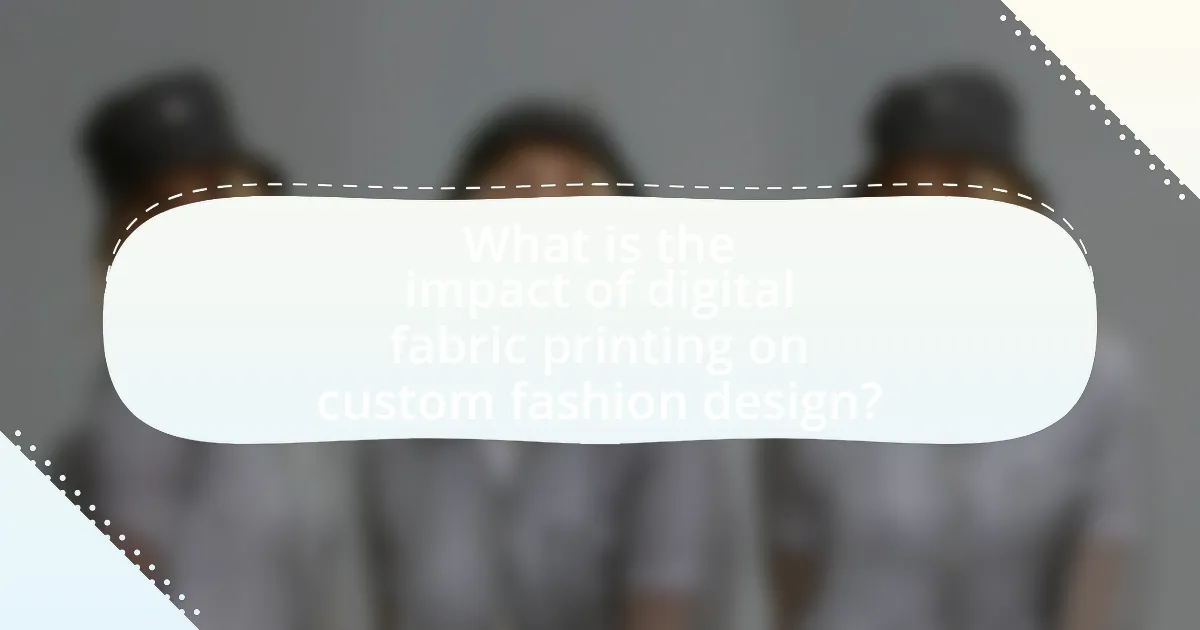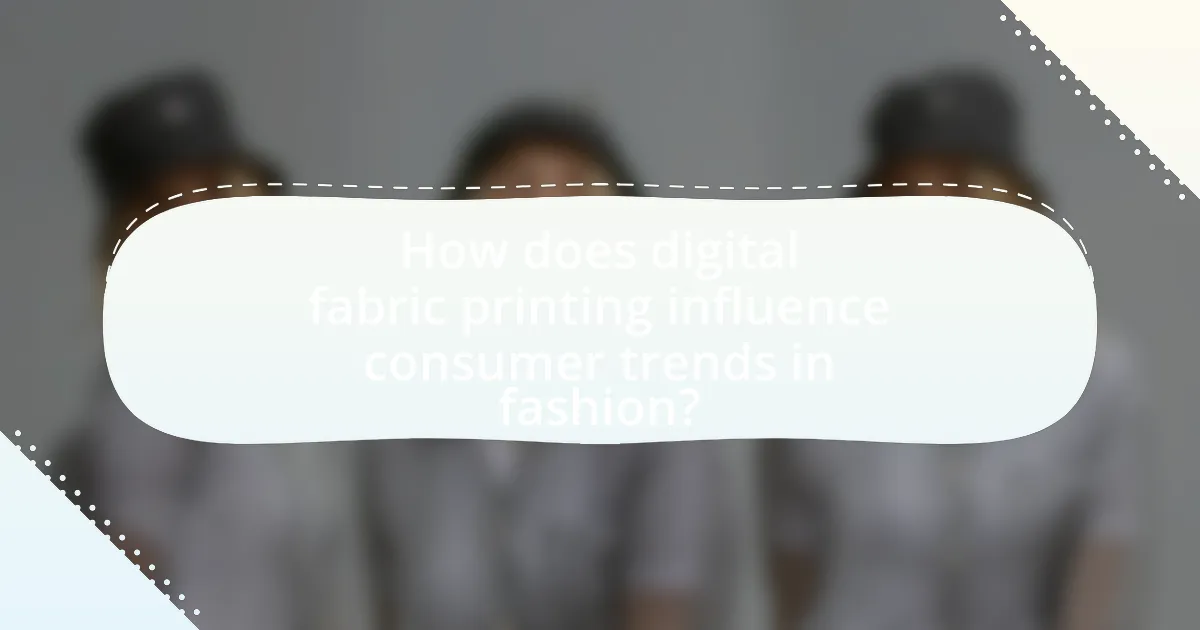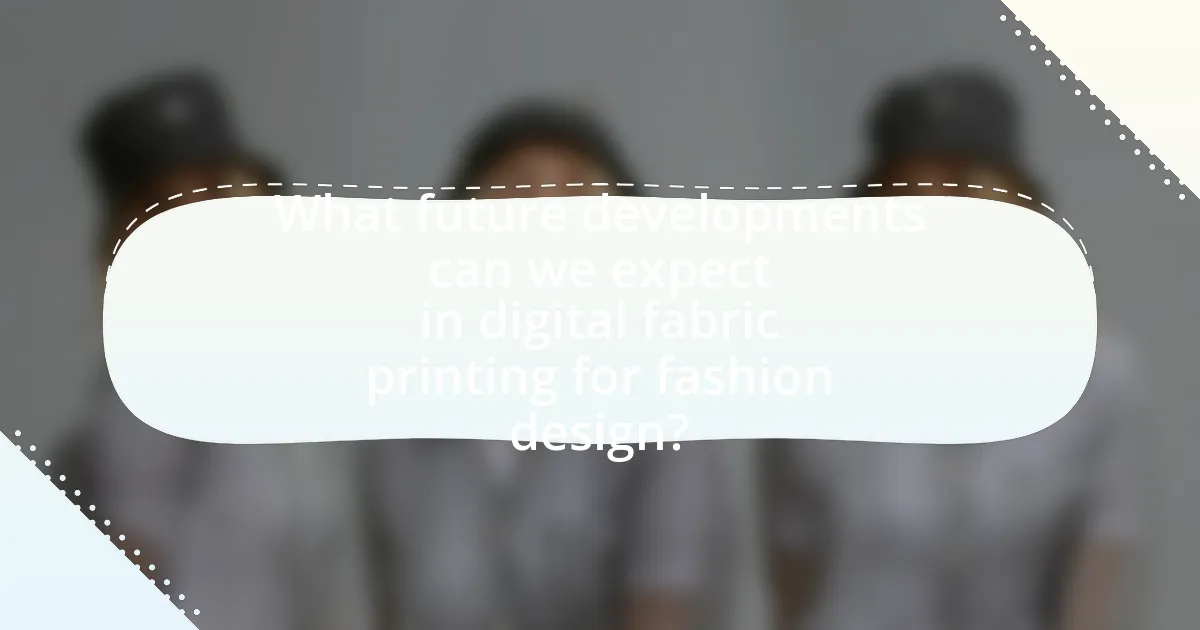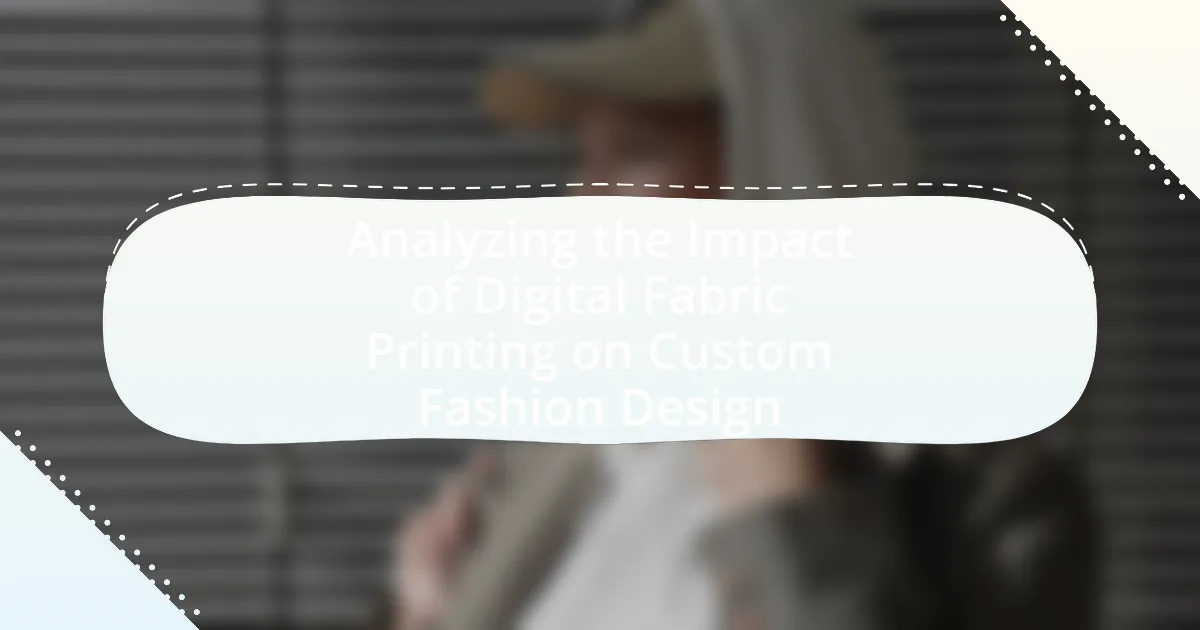Digital fabric printing is revolutionizing custom fashion design by enabling intricate, high-resolution patterns and rapid production of personalized garments. This technology allows designers to create unique pieces quickly and cost-effectively, significantly reducing production time and fabric waste through on-demand printing. Key technologies such as inkjet printing, dye-sublimation, and direct-to-garment printing enhance customization and efficiency, while also aligning with sustainable fashion practices. The article explores the transformative impact of digital fabric printing on the fashion design process, its advantages and challenges, and future developments that may shape the industry.

What is the impact of digital fabric printing on custom fashion design?
Digital fabric printing significantly enhances custom fashion design by enabling intricate, high-resolution patterns and designs that were previously difficult or impossible to achieve with traditional methods. This technology allows designers to create unique, personalized garments quickly and cost-effectively, reducing the time from concept to production. For instance, digital printing can produce small runs of custom designs without the need for extensive setup, which is particularly beneficial for independent designers and small fashion brands. Additionally, studies indicate that digital fabric printing reduces fabric waste by allowing for on-demand production, aligning with sustainable fashion practices. This capability not only fosters creativity but also supports environmentally conscious approaches in the fashion industry.
How has digital fabric printing transformed the fashion design process?
Digital fabric printing has transformed the fashion design process by enabling rapid prototyping and customization of designs. This technology allows designers to print intricate patterns and colors directly onto fabric, significantly reducing the time and cost associated with traditional screen printing methods. For instance, digital printing can produce samples in a matter of hours, compared to weeks for conventional techniques, facilitating quicker iterations and adjustments based on consumer feedback. Additionally, it supports small-batch production, allowing designers to create unique, personalized pieces without the need for large inventory, thus minimizing waste and enhancing sustainability in the fashion industry.
What are the key technologies behind digital fabric printing?
The key technologies behind digital fabric printing include inkjet printing, dye-sublimation, and direct-to-garment (DTG) printing. Inkjet printing utilizes print heads to deposit ink directly onto fabric, allowing for high-resolution designs and a wide color gamut. Dye-sublimation involves transferring dye onto fabric using heat, which results in vibrant colors and durability, particularly on polyester materials. Direct-to-garment printing applies ink directly onto the fabric using specialized inkjet technology, enabling detailed designs and the ability to print on various fabric types. These technologies collectively enhance customization and efficiency in the fashion design process, as evidenced by the growing adoption of digital printing methods in the textile industry.
How does digital fabric printing differ from traditional printing methods?
Digital fabric printing differs from traditional printing methods primarily in its use of digital technology to apply ink directly onto fabric, allowing for greater design complexity and customization. Traditional printing methods, such as screen printing, require physical screens and often involve multiple steps for color application, which can limit design intricacy and increase setup time. In contrast, digital fabric printing enables rapid prototyping and the ability to print intricate designs with a wide color gamut in a single pass, significantly reducing production time and costs. This shift has been supported by industry data indicating that digital printing can reduce waste by up to 90% compared to traditional methods, making it a more sustainable option for custom fashion design.
What advantages does digital fabric printing offer to fashion designers?
Digital fabric printing offers fashion designers several advantages, including design flexibility, reduced production time, and the ability to create intricate patterns. This technology allows designers to print complex designs directly onto fabric, enabling rapid prototyping and customization without the need for extensive setup or screens, which is often required in traditional printing methods. Additionally, digital printing minimizes waste by allowing for on-demand production, which is particularly beneficial in a market that increasingly values sustainability. According to a study by the Textile World, digital printing can reduce fabric waste by up to 90% compared to conventional methods, highlighting its efficiency and environmental benefits.
How does it enhance creativity and design flexibility?
Digital fabric printing enhances creativity and design flexibility by allowing designers to produce intricate patterns and vibrant colors with minimal setup time and cost. This technology enables the rapid prototyping of designs, facilitating experimentation with various styles and materials without the constraints of traditional printing methods. For instance, designers can easily modify designs on-screen and print them directly onto fabric, which significantly reduces lead times and encourages innovative approaches to fashion design. The ability to print on demand also minimizes waste, aligning with sustainable practices while providing designers the freedom to explore unique concepts that may not have been feasible with conventional techniques.
What role does it play in reducing production time and costs?
Digital fabric printing significantly reduces production time and costs by streamlining the design-to-production process. This technology allows for direct printing on fabric, eliminating the need for traditional methods such as screen printing, which requires multiple setup steps and longer lead times. For instance, digital printing can produce designs in a matter of hours, compared to days or weeks for conventional methods. Additionally, it minimizes material waste, as designs can be printed on demand, reducing excess inventory and associated costs. Studies indicate that businesses utilizing digital fabric printing can achieve up to a 50% reduction in production time and a 30% decrease in costs compared to traditional printing methods.
What challenges do designers face when using digital fabric printing?
Designers face several challenges when using digital fabric printing, including color accuracy, fabric compatibility, and production speed. Color accuracy can be problematic due to differences between digital displays and printed outputs, leading to discrepancies in the final product. Fabric compatibility is another challenge, as not all materials yield optimal results with digital printing techniques, which can affect the quality and durability of the prints. Additionally, production speed can be slower compared to traditional methods, particularly for large runs, which may hinder efficiency in meeting market demands. These challenges highlight the complexities designers must navigate to achieve successful outcomes in digital fabric printing.
What are the limitations of digital fabric printing technology?
Digital fabric printing technology has several limitations, including slower production speeds compared to traditional methods, limited fabric compatibility, and potential issues with color accuracy and durability. Production speeds are often slower because digital printing requires time for ink application and drying, making it less efficient for large runs. Additionally, not all fabrics are suitable for digital printing; some materials may not absorb ink properly, leading to subpar results. Furthermore, color accuracy can vary based on the printer and ink used, and the durability of prints may not match that of screen-printed fabrics, which can fade or wash out more quickly. These factors can impact the overall effectiveness of digital fabric printing in custom fashion design.
How can designers overcome common issues related to color accuracy?
Designers can overcome common issues related to color accuracy by utilizing calibrated monitors and color management systems. Calibrated monitors ensure that the colors displayed are true to the intended design, while color management systems help maintain consistency across different devices and materials. Research indicates that using a color calibration tool can improve color accuracy by up to 90%, as it aligns the display output with industry standards. Additionally, designers should create and refer to physical color swatches to verify colors in print, as this practice bridges the gap between digital design and physical output.

How does digital fabric printing influence consumer trends in fashion?
Digital fabric printing significantly influences consumer trends in fashion by enabling customization and rapid production. This technology allows designers to create unique, personalized designs that cater to individual consumer preferences, leading to a growing demand for bespoke fashion items. According to a report by Smithers Pira, the digital textile printing market is projected to reach $3.5 billion by 2024, indicating a shift towards more personalized and on-demand fashion solutions. This trend reflects consumers’ desire for individuality and sustainability, as digital printing reduces waste by allowing for smaller production runs and less excess inventory.
What impact does customization have on consumer purchasing behavior?
Customization significantly enhances consumer purchasing behavior by increasing perceived value and personal relevance of products. When consumers can personalize items, they often feel a stronger emotional connection, leading to higher satisfaction and loyalty. Research indicates that 70% of consumers are more likely to purchase a product if they can customize it to their preferences, as highlighted in a study by Deloitte, which emphasizes that personalization can drive sales and improve customer engagement. This trend is particularly evident in the fashion industry, where digital fabric printing allows for unique designs tailored to individual tastes, further influencing purchasing decisions.
How does digital fabric printing cater to the demand for personalized fashion?
Digital fabric printing caters to the demand for personalized fashion by enabling the creation of unique, custom designs on textiles with high precision and efficiency. This technology allows designers and consumers to print intricate patterns, images, and colors directly onto fabric, facilitating one-of-a-kind garments that reflect individual style preferences. According to a report by Smithers Pira, the digital textile printing market is projected to grow significantly, indicating a rising consumer interest in personalized fashion options. This growth is driven by the ability to produce small runs of customized designs quickly and cost-effectively, meeting the increasing demand for individuality in fashion.
What trends are emerging in sustainable fashion due to digital printing?
Emerging trends in sustainable fashion due to digital printing include reduced waste, increased customization, and the use of eco-friendly inks. Digital printing minimizes fabric waste by allowing for on-demand production, which eliminates excess inventory and unsold garments. Additionally, it enables greater customization, allowing consumers to create unique designs that reflect personal style while promoting a more sustainable approach to consumption. Furthermore, advancements in eco-friendly inks, such as water-based and biodegradable options, contribute to a lower environmental impact compared to traditional printing methods. These trends collectively support the shift towards a more sustainable fashion industry.
How does digital fabric printing affect the supply chain in fashion?
Digital fabric printing significantly streamlines the supply chain in fashion by enabling on-demand production, reducing inventory costs, and minimizing waste. This technology allows designers to print directly onto fabric, which eliminates the need for large production runs and excess stock. According to a study by the Textile Institute, digital printing can reduce fabric waste by up to 90% compared to traditional methods, as it allows for precise designs and color applications. Additionally, the speed of digital printing facilitates quicker turnaround times, enabling brands to respond rapidly to market trends and consumer demands, thus enhancing overall supply chain efficiency.
What changes occur in inventory management with on-demand printing?
On-demand printing significantly alters inventory management by reducing the need for large stockpiles of finished goods. This model allows businesses to produce items only as they are ordered, minimizing excess inventory and associated holding costs. According to a study by the National Retail Federation, companies utilizing on-demand printing can decrease inventory levels by up to 30%, leading to improved cash flow and reduced waste. This shift enables more agile responses to market trends and customer preferences, ultimately enhancing operational efficiency.
How does it influence relationships between designers and manufacturers?
Digital fabric printing significantly influences relationships between designers and manufacturers by fostering collaboration and enhancing communication. This technology allows designers to create intricate and customized designs that can be produced quickly and efficiently, leading to a more agile production process. For instance, the ability to print on demand reduces the need for large inventory, which aligns the interests of both parties by minimizing waste and lowering costs. Additionally, studies show that manufacturers who adopt digital printing technologies can respond more rapidly to market trends, thereby strengthening their partnerships with designers who seek timely and innovative solutions.

What future developments can we expect in digital fabric printing for fashion design?
Future developments in digital fabric printing for fashion design will likely include advancements in sustainability, increased customization options, and enhanced printing technologies. Innovations such as eco-friendly inks and materials are being prioritized to reduce environmental impact, aligning with the fashion industry’s shift towards sustainability. Additionally, improvements in software and hardware will enable designers to create more intricate and personalized designs, allowing for on-demand production that minimizes waste. For instance, the integration of artificial intelligence in design software can facilitate real-time adjustments and unique pattern generation, enhancing the creative process. These trends are supported by industry reports indicating a growing demand for sustainable practices and personalized fashion experiences.
How might advancements in technology shape the future of digital fabric printing?
Advancements in technology will significantly enhance the future of digital fabric printing by improving speed, quality, and customization capabilities. Innovations such as faster printing machines, advanced ink formulations, and artificial intelligence for design optimization will enable manufacturers to produce high-quality prints more efficiently. For instance, the introduction of direct-to-garment (DTG) printing technology has already reduced production times and costs, allowing for on-demand printing that meets consumer demands for personalized designs. Additionally, developments in eco-friendly inks and sustainable printing processes will address environmental concerns, making digital fabric printing more appealing to both consumers and manufacturers. These technological improvements will ultimately lead to a more dynamic and responsive custom fashion design industry.
What innovations are on the horizon for digital printing techniques?
Innovations on the horizon for digital printing techniques include advancements in ink formulations, such as eco-friendly and biodegradable inks, which enhance sustainability in the printing process. Additionally, developments in printhead technology are enabling higher resolution and faster printing speeds, allowing for more intricate designs and quicker turnaround times. Research from Smithers Pira indicates that the digital textile printing market is expected to grow significantly, driven by these technological improvements and the increasing demand for customization in fashion design.
How could artificial intelligence impact design processes in digital fabric printing?
Artificial intelligence could significantly enhance design processes in digital fabric printing by automating design generation and optimizing material usage. AI algorithms can analyze trends and consumer preferences, enabling designers to create personalized patterns and styles that resonate with target audiences. For instance, AI-driven tools like Adobe Sensei utilize machine learning to suggest design modifications based on user input and historical data, streamlining the creative process. Additionally, AI can improve efficiency by predicting fabric behavior during printing, thus reducing waste and ensuring better quality outcomes. This integration of AI into design processes not only accelerates production timelines but also fosters innovation in custom fashion design.
What best practices should designers follow when integrating digital fabric printing?
Designers should follow best practices such as selecting appropriate fabrics, optimizing designs for digital printing, and ensuring color accuracy when integrating digital fabric printing. Choosing the right fabric is crucial because different materials react differently to ink, affecting the final print quality. Optimizing designs involves using high-resolution images and considering the limitations of the printing technology to achieve the best results. Ensuring color accuracy requires designers to work with color profiles and conduct test prints to verify that the colors match their expectations, as digital printers can vary in color output. These practices enhance the quality and effectiveness of digital fabric printing in custom fashion design.
How can designers effectively choose materials for digital printing?
Designers can effectively choose materials for digital printing by assessing the compatibility of the material with the printing technology and the desired outcome. Key factors include the material’s absorbency, texture, and weight, which influence ink adhesion and color vibrancy. For instance, materials like cotton and polyester are commonly used due to their excellent ink absorption properties, allowing for high-quality prints. Additionally, understanding the specific requirements of the digital printing process, such as the type of inks used (dye-sublimation or pigment-based), helps in selecting materials that will yield the best results. Research indicates that using the right material can enhance print durability and color accuracy, which is crucial for custom fashion design.
What strategies can enhance the quality of printed designs?
To enhance the quality of printed designs, utilizing high-resolution images and ensuring proper color calibration are essential strategies. High-resolution images prevent pixelation and maintain clarity, while accurate color calibration ensures that the printed colors match the intended design, which is critical in fashion design where color fidelity is paramount. Research indicates that designs printed with a resolution of at least 300 DPI (dots per inch) yield superior results, as this standard is widely recognized in the printing industry for achieving sharp and vibrant outputs. Additionally, employing advanced digital printing technologies, such as dye-sublimation or direct-to-garment printing, can further improve the quality by allowing for intricate details and a broader color spectrum.

Leave a Reply